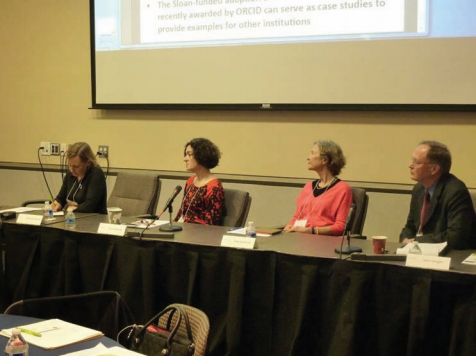
Since the Open Researcher and Contributor Identifier (ORCID) registry of unique researcher identifiers was launched a year ago, more than 362,000 new ORCID iDs have been created. More than 1.3 million DOIs have been connected to ORCID accounts. On 30 October 2013, representatives of publishers, funding agencies, and societies gathered in Washington, DC, to collaborate on ways in which the three unique sectors can use ORCID iDs effectively.
The key to effective ORCID implementation is not only for publishers to incorporate iDs into their publishing management systems but for funders and universities to integrate ORCID iDs into their workflows, making them the identifications of choice, explained Laurie Haak, executive director at ORCID.
Several international consortia are recommending to their governments that ORCID become the official registry for researchers throughout their countries.
Users can see ORCID iDs starting to become established. PubMed now incorporates ORCID and allows users to search by ORCID iD. The Nature Publishing Group and Hindawi Publishing have integrated ORCID iDs and are now depositing ORCID data with metadata deposits to CrossRef. These systems facilitate the inclusion of new papers in a person’s ORCID profile in an automatic way.
Through microgrants funded by the Alfred P. Sloan Foundation, several universities and societies are also implementing ORCID. The Society for Neuroscience and the American Geophysical Union are planning to use ORCID to identify society members in all their databases.
Harvard University, Boston University, the Chalmers University of Technology, the University of Michigan, and numerous other universities and research institutions are integrating ORCID into a multitude of campus systems, including faculty profile systems, institutional repositories, and human-resources systems.
Funders are also integrating and requiring ORCID iDs as part of their grantproposal systems. The Wellcome Trust, the National Institutes of Health, and the US Department of Energy have incorporated ORCID into some of their systems, and researchers can expect to see requests for their ORCID iDs when they apply for grants in the future.
Rebecca Bryant, director of community outreach at ORCID, spoke of a robust ambassador program. Fifty-one ambassadors from 22 countries are blogging, tweeting, meeting with their colleagues, and presenting posters at conferences to spread the word about ORCID.
ORCID is still in the early stages of development, and clearly there is no shortage of ideas on how to use ORCID iDs in multiple scenarios. While stakeholders are conjuring up the best uses, ORCID continues to make the ORCID registry site more robust. The site is available in five languages, and a mobile version will be released soon. For more information about ORCID iDs, visit www.ORCID.org.
ANGELA COCHRAN is director of journals at the American Society of Civil Engineers, Reston, Virginia. She is a volunteer ambassador for ORCID.
